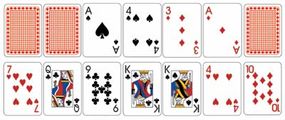For many years, 7-Card Stud was easily the most-played poker game. Then, in the '70s, Texas Hold'em arrived, and it has been gaining popularity during the past decade. It wasn't bad enough that Hold'em became more popular; now Omaha/8 is arguably the second-most-popular poker game.
Don't let any of this, however, mislead you into thinking that 7-Card Stud is no longer important to the poker world. It is still offered in most fair-size card rooms, at some tournaments, and is often played by many at home. 7-Card Stud is an intricate card game with many details to learn. If you are looking for a way to gain more knowledge about the game, you have found the right article. Let's get down to basics:
Advertisement
7-Card Stud is played both high only (meaning the highest hand wins) and high-low/hi-lo (meaning that the highest hand splits the winnings with the lowest hand). The discussion in this article will center on the high-only version. 7-Card Stud is also played at both set limit and pot (the pot is the total amount that has been bet in a single game) limit. Set limit means that there's a preset limit to how much you can bet, and pot limit means that you can bet as much money as there is in the pot at any given time.
Up to eight players may play in a 7-Card Stud game. It is possible that there will not be enough cards if all eight players make it to the end of the game, especially if the dealer burns (discards) a card prior to dealing to the active players. In these infrequent cases, instead of dealing a card to each active player, the dealer turns a "community" card (a card that all active players can use).
Before the deal, each player places an ante into the pot and then receives two down cards (hole cards) and one face up card. The player with the lowest face up card (an ace is high in this situation) is required to start the betting action with an initial bet called the "bring-in." The bring-in must be at least the required minimum amount agreed upon before the game. Play continues to the left with either calls (to equal the previous opponent's bet), raises (to bet higher than the previous opponent), or folds (to resign). For example, if a player thought he had a strong hand and good chance of winning the round, he would raise the bet in attempt to generate the largest pot possible.
After all betting is completed, a fourth card is dealt face up to each player who has not folded. From this point on, the player with the highest hand showing starts the action. For example, if the high hand (excluding the hole cards) is a pair after the fourth card is dealt, the player with this pair must check (to decline to bet or to pass when it is your turn to act), bet, or fold. Because there is no bring-in requirement after the first betting round, players do not need to fold until there is a bet. Once there is a bet, players left in the game, in turn, must call, raise, or fold. It is possible for players to check around the table, thus having a round with no bets.
A fifth card is dealt face up followed by a betting round, and then a sixth card is dealt face up followed by another round of betting. The seventh card is dealt to each player face down, and the final round of betting starts. Each round is often called a "street" (the third card is called third street, the fourth card is called fourth street, and so on through seventh street).
A skill that is much more important in 7-Card Stud than most other forms of poker is memory. All good 7-Card Stud players remember what cards their opponents were showing before they folded. This is important because players need to know what cards are still out there that can help them and which ones are already gone. Like most forms of poker, other important skills include reading players, reading hands, reading betting patterns, and determining pot odds (the odds of winning the pot) and starting hand selection (which starting hands are worth playing).
The best starting hand is two aces in the hole and an ace showing, followed by other three-of-a-kind hands (often called rolled-up trips). Next is a high pair in the hole because it is not only a high pair but also a hidden one. High pairs with one card showing, especially if it is the highest card showing, are also strong starting hands. Hands with strong flush and straight possibilities are also reasonable starting hands.
Like all forms of poker, 7-Card Stud is a game of information. Always be aware of what cards your opponents have showing and what hands they could possibly have. Sometimes you'll notice players who are just learning the game calling bets on the last betting round with hands that can't beat what an opponent has showing. For example, Player A has two aces showing and Player B calls with only a pair of kings. If Player B had simply been paying attention, he/she could have saved at least one bet.

Just like Hold'em and Omaha, the best 7-Card Stud players are tight and aggressive, and they can read players, hands, and situations. Sometimes poor players can win for long stretches of time in Hold'em because of short-term variance, but poor players in 7-Card Stud usually struggle because of a reduced "luck" factor. Understanding what cards are still available to help your hand and pot odds are of the utmost importance to a successful 7-Card Stud player.
For more information on 7-Card Stud Poker and other variations, try the following links:
- To see all of our articles on poker rules and advice, go to our main article on How To Play Poker.
- For an simple overview of the game, brush up on some Poker Basics.
- Take up the new "most popular version of poker" by learning How to Play Texas Hold 'Em Poker.
- For a real challenge, learn the ins and outs of a complex form of poker, and become skilled at How to Play Omaha Poker.
Advertisement

